Found some BHP this week.
Discussion
So, I thought I might do some fine tuning this week, and so to test my success or failure, I did a before and after dyno run.
First port of call was removal of the secondary cats in the exhaust system which is a fairly common modification, but then I turned my attention to the throttle bodies that I noticed during cleaning, could flow a bit better.
Removing them completely from the car, it is clear they are mass produced with little attention to flow. They do the job they are designed for perfectly, but that does not mean they cannot be improved.
Here, you can see the sharp step/lip left in the throttle body ahead of the throttle plate (butterfly) during the machining process of the cast body.
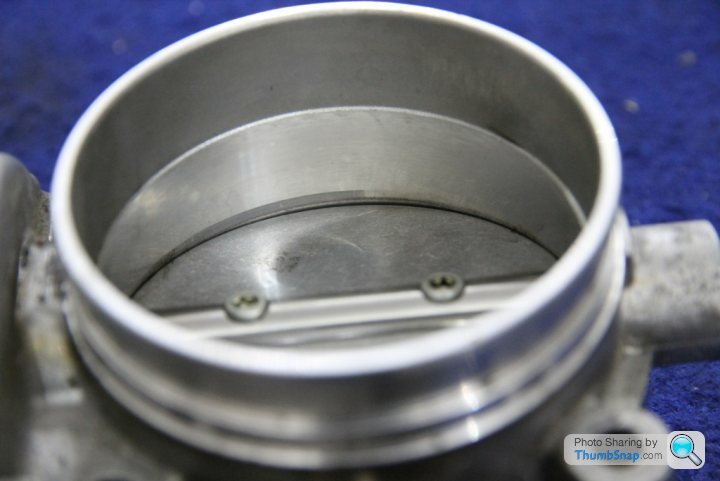
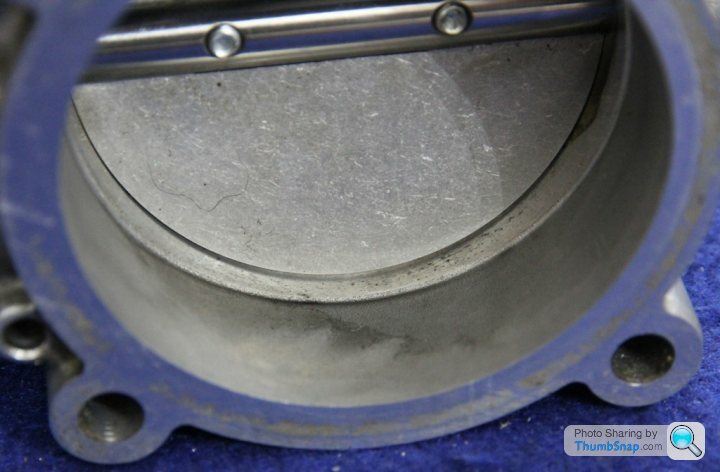
There is an even worse step downstream of the throttle plate seen here.
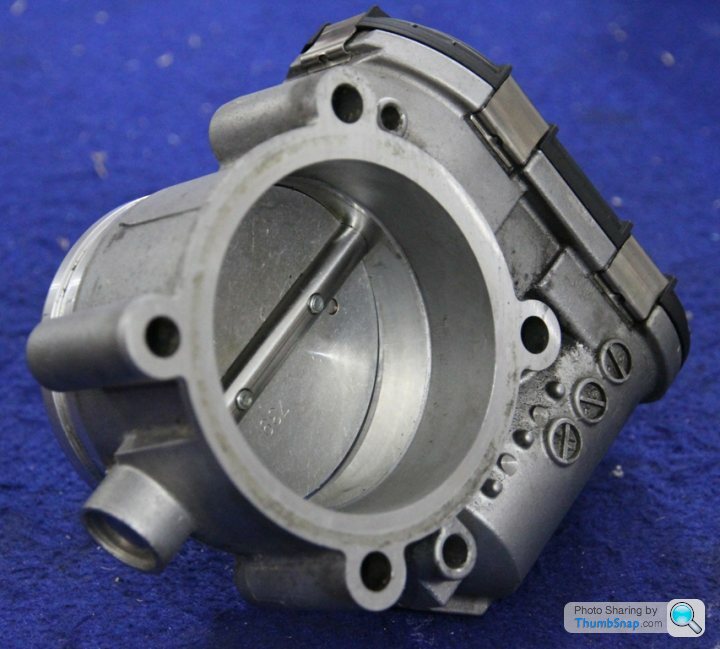
Seen in close up, it can be seen the small area around the throttle plate, a couple of millimeters wide where the throttle plate seals.
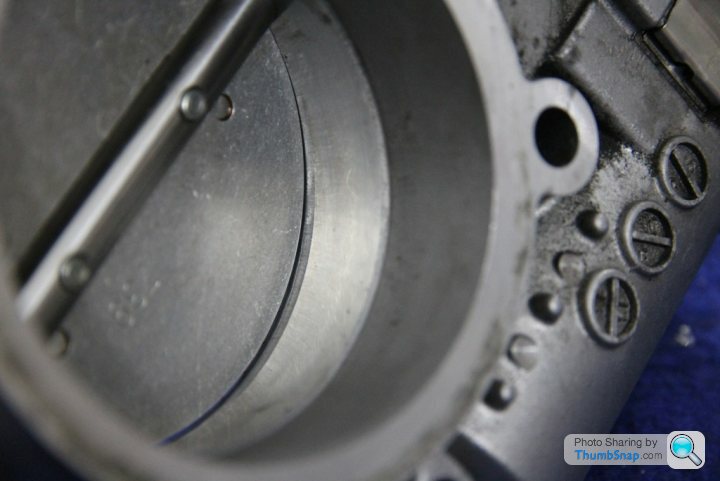
When porting the throttle body, you are trying to achieve a smooth, and therefore less turbulent and greater airflow, without going to the extremes of boring the throttle body bigger and replacing the throttle plate. When porting it is important not to extend the grinding into the plate seat area.
In this pretty poor photo, you can hopefully see the protrusion into the throttle area of the throttle plate screws, both the squared oversize head of the bolt, plus the extension of the thread too long for the spindle.
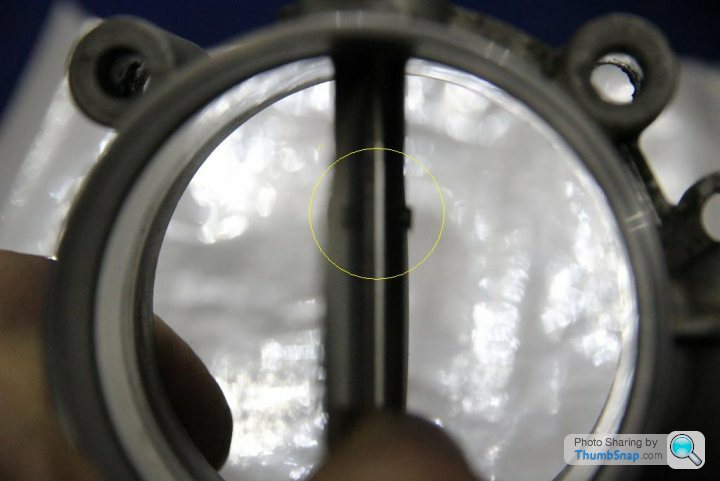
After removal of the throttle plate, I ported the intake side of the throttle body to allow a smooth, step free transition from the inlet to the seal area of the throttle plate.
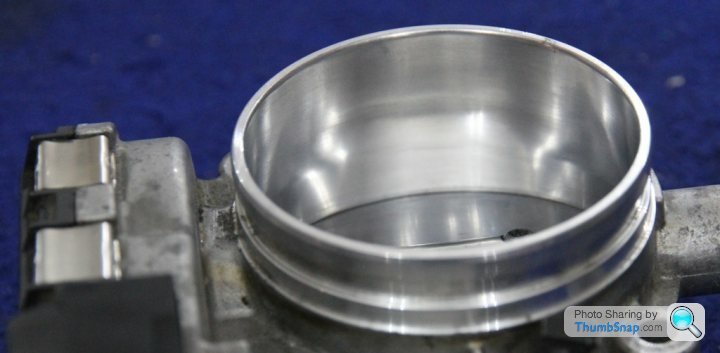
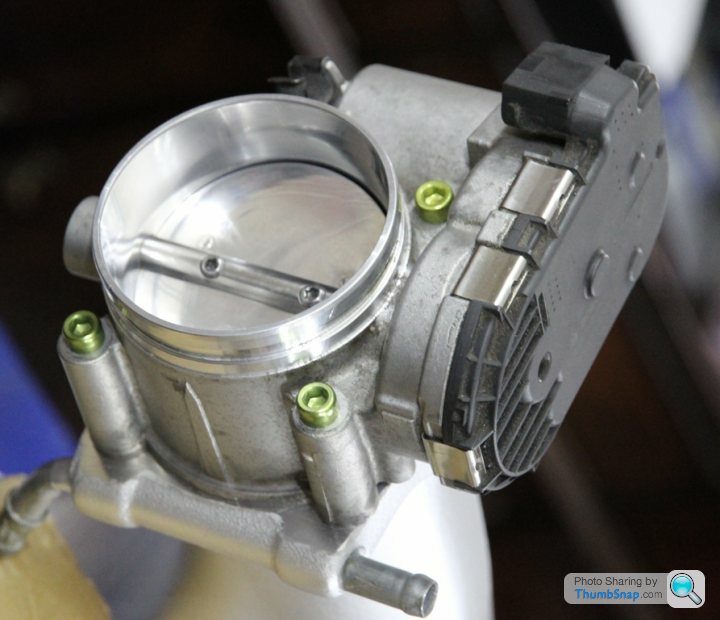
Whilst the attachment screws were out, I "mushroomed" the heads to improve flow and shortened them, refitting them with some threadlock.
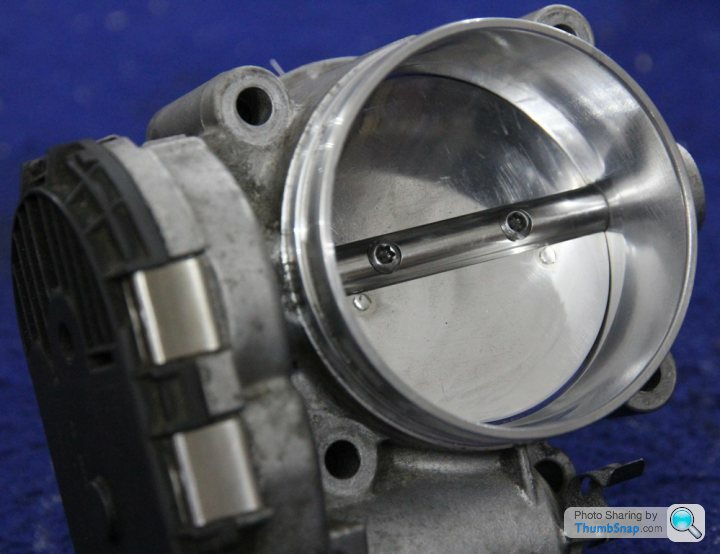
Here you can see the ported body after the throttle plate with the shortened screws.
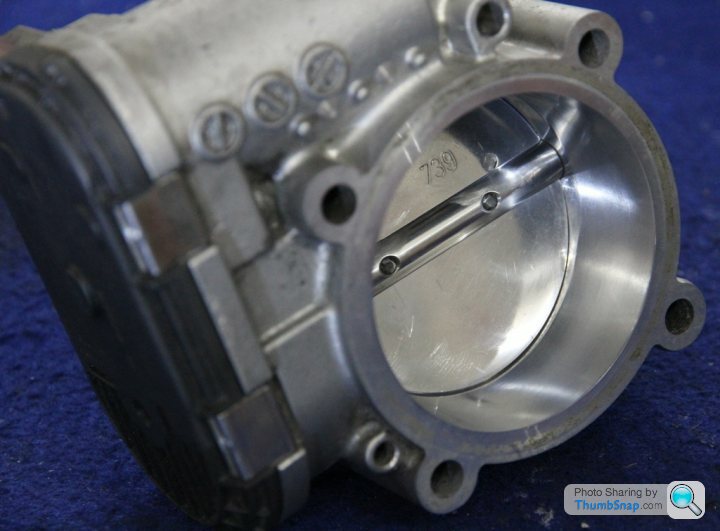
I then mounted the throttle to a spare manifold to see how much of a step there was between the throttle body and the manifold casting, you can see there is quite a step.
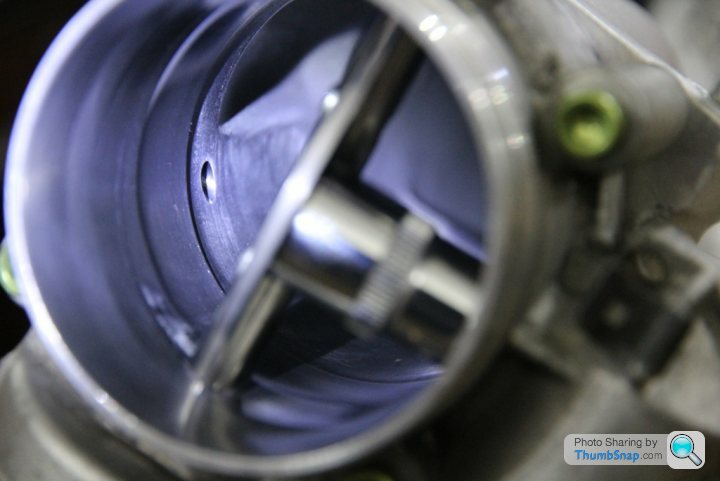
With a little more work, I was able to match the outlet of the throttle body to the intake of the inlet manifold.
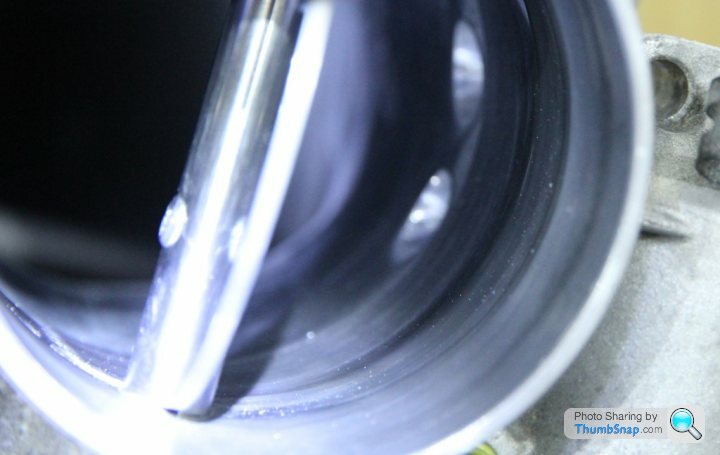
I then returned to the dyno after running the car for a few miles to let the ECU make any adaptations and was pretty chuffed with the results.
There are 2 traces shown on the first runs, one before I remapped the ECU where we made 430.7 bhp (red trace) and the second where, after optomising the fuel and timing, we got a result of 436.7 bhp (blue trace). Not much at just 6 bhp demonstrating Aston Martin got their programming pretty well optimised.
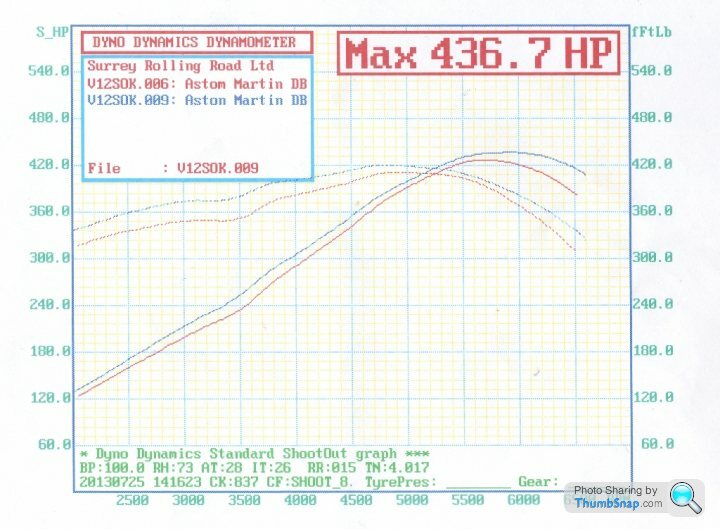
The next dyno session is after the work described above, and I was very pleased to see the results.
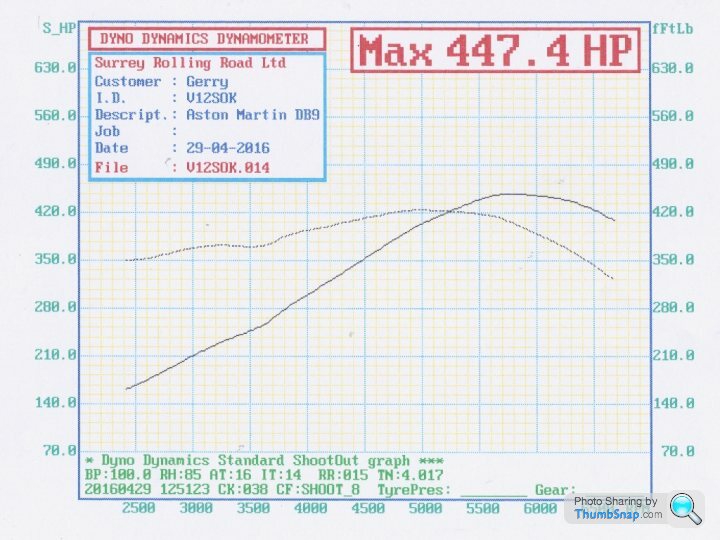
So, I made an extra 10.7 bhp for my sins. Not bad for a few hours playing. Next project is to port the intake manifolds and port match them to the cylinder heads. They need to come off anyway when I replace the plugs, so whilst they are off, a clean, paint and port will be on the agenda.
Stay tuned.
First port of call was removal of the secondary cats in the exhaust system which is a fairly common modification, but then I turned my attention to the throttle bodies that I noticed during cleaning, could flow a bit better.
Removing them completely from the car, it is clear they are mass produced with little attention to flow. They do the job they are designed for perfectly, but that does not mean they cannot be improved.
Here, you can see the sharp step/lip left in the throttle body ahead of the throttle plate (butterfly) during the machining process of the cast body.


There is an even worse step downstream of the throttle plate seen here.

Seen in close up, it can be seen the small area around the throttle plate, a couple of millimeters wide where the throttle plate seals.

When porting the throttle body, you are trying to achieve a smooth, and therefore less turbulent and greater airflow, without going to the extremes of boring the throttle body bigger and replacing the throttle plate. When porting it is important not to extend the grinding into the plate seat area.
In this pretty poor photo, you can hopefully see the protrusion into the throttle area of the throttle plate screws, both the squared oversize head of the bolt, plus the extension of the thread too long for the spindle.

After removal of the throttle plate, I ported the intake side of the throttle body to allow a smooth, step free transition from the inlet to the seal area of the throttle plate.


Whilst the attachment screws were out, I "mushroomed" the heads to improve flow and shortened them, refitting them with some threadlock.

Here you can see the ported body after the throttle plate with the shortened screws.

I then mounted the throttle to a spare manifold to see how much of a step there was between the throttle body and the manifold casting, you can see there is quite a step.

With a little more work, I was able to match the outlet of the throttle body to the intake of the inlet manifold.

I then returned to the dyno after running the car for a few miles to let the ECU make any adaptations and was pretty chuffed with the results.
There are 2 traces shown on the first runs, one before I remapped the ECU where we made 430.7 bhp (red trace) and the second where, after optomising the fuel and timing, we got a result of 436.7 bhp (blue trace). Not much at just 6 bhp demonstrating Aston Martin got their programming pretty well optimised.

The next dyno session is after the work described above, and I was very pleased to see the results.

So, I made an extra 10.7 bhp for my sins. Not bad for a few hours playing. Next project is to port the intake manifolds and port match them to the cylinder heads. They need to come off anyway when I replace the plugs, so whilst they are off, a clean, paint and port will be on the agenda.
Stay tuned.
Edited by 8Tech on Friday 29th April 16:41
What a cracking gain for a bit of Dremel work?! How does the butterfly still fit if you removed the lip and made the hole an uniform larger non stepped size though? I ask as an amateur who used to file the top of the throttle slide in his moped carb to make it 'lift higher' and hence release more horses 

I am always interested to read about technical matters Gerry, but the cars of today are too complex for my spanners and knowledge.
Your afterwards dyno. test followed two modifications. Do you think the majority of the BHP increase would have been derived from the removal of the secondary cats? It would have been interesting to know the effect of your work on the throttle bodies.
I had better not suggest refitting the cats and do another dyno test.
Thanks for posting.
moveover said:
Did you also sharpen the leading edge of the butterfly to improve air flow? I remember that particular tune-up from the David Vizard book on tuning the A-series engine in the original mini!
No, I decided not to risk touching the butterfly itself just in case I touched on the sealing edge. Similarly, I did not cut away half of the throttle spindle to increase flow because of the risk of spindle failure and the increased risk of failing to secure the butterfly.Ken Figenus said:
What a cracking gain for a bit of Dremel work?! How does the butterfly still fit if you removed the lip and made the hole an uniform larger non stepped size though? I ask as an amateur who used to file the top of the throttle slide in his moped carb to make it 'lift higher' and hence release more horses 
I effectively "coned" the entry and exit to/from the butterfly without touching the throat area where the butterfly seals. Attached is an awful diagram of what I did if it helps. No, I did not do Art at school! The turbulent flow areas effectively reduce the flow far more than just the reduction in cross sectional area, they reduce the laminar flow through the throttle due to the reduction in air speed in the turbulent areas.
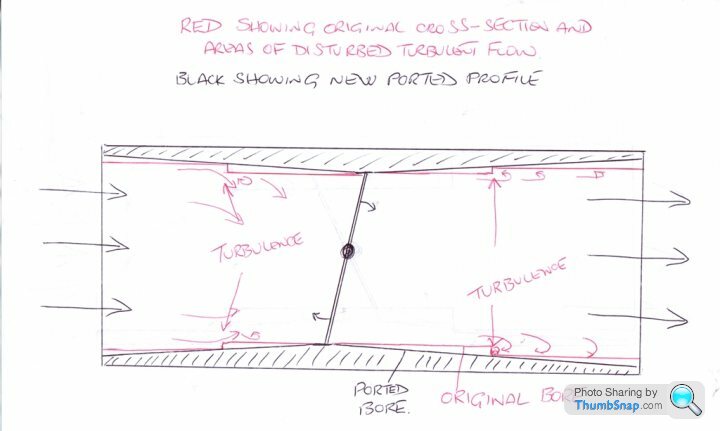
Edited by 8Tech on Friday 29th April 23:58
Jon39 said:
Your afterwards dyno. test followed two modifications. Do you think the majority of the BHP increase would have been derived from the removal of the secondary cats? It would have been interesting to know the effect of your work on the throttle bodies.
I would say most of the power gain was from the removal of the cats but any gain from the throttles is a gain nonetheless.With dyno time expensive and difficult to arrange, I do not have the funds or luxury unfortunately of doing a run with every individual mod.
Unless you wanna sponsor me?
He he.
bogie said:
I would have thought that most of the gain would have come from the cat removal, but still for a few hours DIY it all helps
Im not sure that I would notice 10bhp in a 1.6 ton car, but still, its more about the thought of more power and a bit more noise of course
I agree, the seat-of-the-pants dyno cannot feel any difference, but thats not the point for me, just knowing I have achieved/improved something is satisfying enough.Im not sure that I would notice 10bhp in a 1.6 ton car, but still, its more about the thought of more power and a bit more noise of course

Handyman2009 said:
8Tech,
What was you increase in ft/TQ ? And are these numbers at the wheels ?? I thought that the V8 had 420HP and 356ft/TQ
My DB9 is a V12. No change in torque measured. BHP is a corrected figure at the crankshaft. The car ran slightly leaner though, approaching the ideal 12.5:1 AF ratio for max power rather than the previos rich (safer) ratio of 11.5:1. The air/fuel ratio suddenly drops from around 14.0:1 from 1000 to around 3000 rpm down to around 12.0:1 and then hovers around that all the way to the redline.What was you increase in ft/TQ ? And are these numbers at the wheels ?? I thought that the V8 had 420HP and 356ft/TQ
No other changes apart from the new larger tailpipes that would have absolutely no power gain, or air fliter/induction changes.
Gassing Station | Aston Martin | Top of Page | What's New | My Stuff



